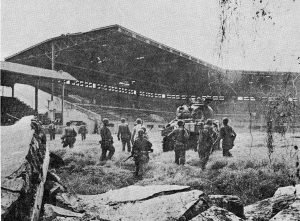Seventy-six years ago, the U.S. Army and the Imperial Japanese Army fought for control of Manila, resulting in the destruction of the city and the deaths of over 100,000 Filipino civilians. The Battle of Manila was the largest urban contest of the Pacific War between the United States and Japan, which was otherwise mostly fought on small, sparsely populated islands and in the wastes of the Pacific itself.
Memory of the massacre received attention during last year’s 75th anniversary, but the oncoming pandemic blunted much of the planned commemoration both in the United States and the Philippines. More recently, the release of Ian Toll’s magisterial “Twilight of the Gods,” the third volume in his best-selling history of the Pacific War, has drawn attention back to the battle. Toll’s detailed account of the battle helps elevate it from being a historical backwater, overlooked at the time and later because of the strategic situation in both the Atlantic and the Pacific, and because of a pre-emptive declaration of victory on the part of General Douglas MacArthur.
U.S. forces landed on Luzon on January 9, 1945, and rapidly overran most of the island apart from Manila and the mountainous north. The Imperial Japanese Army commander, Tomoyuki Yamashita, concentrated his main defense in the north, but did not abandon the city. The Battle of Manila began on February 3, 1945, as U.S. Army forces entered the outskirts of the city. Initial actions belied the eventual ferocity of the battle, as U.S. and Japanese forces struck a temporary truce at a local university that had been converted into a prisoner of war camp, enabling the safe transit of both the detainees and the Japanese forces that had been guarding them.
By February 5, U.S. forces began to enter areas of the city that Japanese forces had heavily fortified. MacArthur had imposed sharp limits on the use of aerial bombing, and some limitations on the use of artillery, but the latter fell away as the determination of Japanese defenders became apparent. MacArthur exacerbated the U.S. problem by declaring victory on February 6, while most of Manila was still in Japanese hands. The situation rapidly deteriorated as Japanese forces entrenched and fortified positions in the city, often in buildings dated to the 17th century. The troops occupying the city, primarily belonging to the Imperial Japanese Navy, quickly lost cohesion and discipline, and began mass, systematic reprisals and massacres against Filipino civilians.
Over the next three weeks, U.S. and Japanese forces systematically destroyed the oldest parts of the city, with hand-to-hand fighting in some areas and massive artillery bombardments in others. The fighting and the artillery barrages destroyed many buildings that had survived since the early Spanish colonial period, and which represented the historical heritage of the Philippine people. Japanese depredations against civilians included not only abject massacres (including attacks against co-belligerent Germans who lived in the cities) but also the extensive use of human shields. Organized Japanese resistance ended in early March.
Altogether, the battle incurred over 6,000 U.S. casualties, 16,000 Japanese (almost the entire garrison killed) and between 100,000 and a quarter million Filipino civilians.
Manila is unlike any of the other great urban battles of the World War II era in that it took place in area that was not decisive to the conclusion of the conflict. The Battles of Shanghai and Nanking were critical to the defense of China; Stalingrad enabled the destruction of a significant portion of the Wehrmacht; Berlin was obviously critical to forcing the surrender of Nazi Germany. This inevitably evokes the question that my next column will deal with: Could the destruction of Manila have been avoided?

































